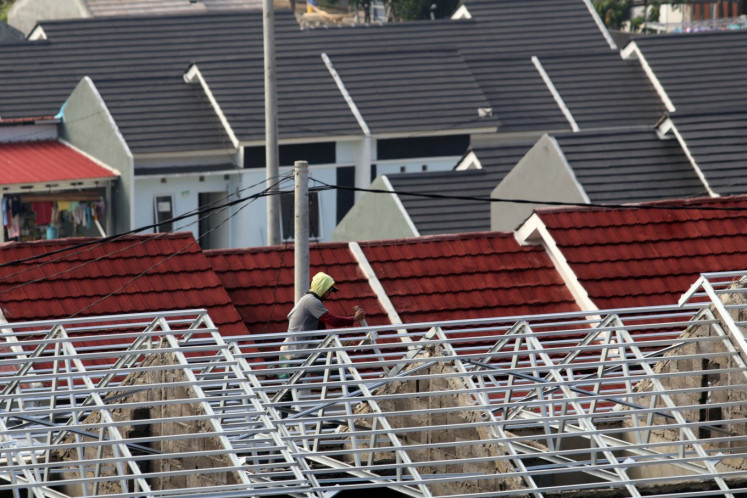Popular Reads
Top Results
Can't find what you're looking for?
View all search resultsPopular Reads
Top Results
Can't find what you're looking for?
View all search resultsFinger-pointing over tsunami warning
“No tsunami detection buoys are in operation in our country right now, which are necessary to detect such waves early."
Change text size
Gift Premium Articles
to Anyone
 Desperate times: Earthquake victims loot a warehouse in Mamboro in North Palu, Central Sulawesi, on Monday. Residents from North Palu to Donggala’s western coast have been looting warehouses and stores to obtain basic commodities as the humanitarian assistance they are in dire need of has yet to arrive to disaster-struck areas. (Antara/Muhammad Adimadja)
Desperate times: Earthquake victims loot a warehouse in Mamboro in North Palu, Central Sulawesi, on Monday. Residents from North Palu to Donggala’s western coast have been looting warehouses and stores to obtain basic commodities as the humanitarian assistance they are in dire need of has yet to arrive to disaster-struck areas. (Antara/Muhammad Adimadja)
F
our days after a 7.4-magnitude quake hit Central Sulawesi, the Meteorology, Climatology and Geophysics Agency (BMKG) has stood by its decision to lift a tsunami warning soon after it was issued.
When the powerful earthquake jolted the provincial capital of Palu and its surroundings on Friday, the agency announced a tsunami warning for the western and central parts of Sulawesi at 5:07 p.m. Jakarta time, five minutes after the quake hit the island.
The BMKG, however, decided to retract the warning around 30 minutes later, after receiving a flurry of information, including a field observation report from a staff member of its office in Palu.
“The staff member reported that he had seen indications of tsunami waves at the harbor [of Palu] at around 6:27 p.m. local time, including a stranded boat. At that time, the height of the water at the harbor was around 30 centimeters,” BMKG chairwoman Dwikorita Karnawati told The Jakarta Post over the phone on Sunday.
Hamzah Latief, a tsunami expert from the Bandung Institute of Technology (ITB), questioned the BMKG’s decision to lift the tsunami warning only minutes after the waves hit the shore on Friday.
Hamzah said Palu was prone to experiencing a tsunami in the event of a powerful earthquake. Based on his research on the Palu-Koro tectonic fault line in 2012, which included a simulation of a tsunami in Palu Bay, the city of Palu could be hit by tsunami waves measuring 1 to 2 meters in height.
In Hamzah’s simulation, the first waves would hit the city 20 to 25 minutes after the quake.
“It was too early for the warning to be withdrawn, because the tsunami struck Mamuju [in West Sulawesi] around 50 minutes after the quake happened [on the Palu-Koro fault line],” Hamzah said.
Dwikorita further defended the BMKG’s decision by saying that the agency had analyzed widely shared mobile phone footage showing a tsunami hitting the coast of Palu. The footage purportedly shows a number of restaurants near Palu Grand Mall being swept away by a wave.
“Based on our analysis, three waves hit Palu’s beach around dusk, with the third one and the highest sweeping away houses and kiosks. The waves hit the beach within a duration of 2.5 minutes,” Dwikorita said, adding that the tsunami alert ended at 6:37 p.m., minutes after the third wave hit land.
She also denied claims that more tsunami waves had occurred after the alert ended. “After the third wave, there were no more.”
Many have blamed the absence of an early-warning system deployed by the government for the loss of life in Palu.
Another tsunami expert, Abdul Muhari, said Indonesia lagged behind other countries in building and maintaining a tsunami detection system.
Abdul said countries like Japan, which frequently deals with earthquakes and tsunamis, had installed and were operating more equipment to detect earthquakes than Indonesia. For example, there would be one to five seismographs placed in a subdistrict as well as layers of tsunami detector buoys in its waters.
“Despite [Japan’s] ample equipment, there was still a loophole that caused a high number of casualties during the 2011 earthquake and tsunami,” Abdul said. “Indonesia, by contrast, only operates a limited amount of equipment.”
National Disaster Mitigation Agency (BNPB) spokesman Sutopo Purwo Nugroho said Indonesia had been having problems installing real-time tsunami detection equipment since 2012.
“No tsunami detection buoys are in operation in our country right now, which are necessary to detect such waves early. Most of them are broken because of, for example, vandalism,” Sutopo said, adding that the procurement of such equipment could run up against budgeting constraints.










